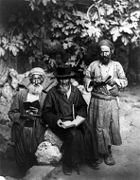Four Holy Cities
From Wikipedia, the free encyclopedia
| This article needs additional citations for verification. Please help improve this article by adding reliable references. Unsourced material may be challenged and removed. (July 2009) |

Nineteenth century out-of scale map of Judaism's four holy cities, with Jerusalem occupying the upper right quadrant, Hebron beneath it, the Jordan River running top to bottom, Safed in the top left quadrant, and Tiberias beneath it. Each of the four cities includes representations of the sacred shrines, as well as the graves of sainted rabbis and holy men.
The Four Holy Cities is the collective term in Jewish tradition applied to the cities of Jerusalem, Hebron, Tiberias, and Safed: "Since the sixteenth century the holiness of Palestine, especially for burial, has been almost wholly transferred to four cities—Jerusalem, Hebron, Tiberias, and Safed."[1]
| HaYishuv haYashan |
 |
| Jewish life in the Holy Land before Modern Zionism |
| Founders: |
|---|
| Nahmanides • Yechiel of Paris Bartenura • Yehuda he-Hasid |
| Finance: |
| Kollel • Halukka • Etrog |
| Communities: |
| Sephardim • Perushim • Hasidim |
| Synagogues: |
| Ramban • Ari • Hurva • Shomrei HaChomos |
| Related articles: |
| History of the Jews in the Land of Israel • History of Zionism (Timeline) • Haredim and Zionism • Edah HaChareidis • Neturei Karta • ShaDaR • Yishuv • Three Oaths |
- Jerusalem has been the holiest city in Judaism and the spiritual homeland of the Jewish people since the 10th century BCE.[2] Jerusalem is associated with the element of fire (a reference to the continuous sacrificial fires kept burning in the Holy Temple.)
- Hebron is the burial place of the Jewish patriarchs, as well as the first man and woman Adam and Eve. Biblically, it is the first capital of King David. Hebron is associated with the element of earth (a reference to the Cave where the patriarchs and matriarchs were buried.)
- Safed (Tz'fas) came to be regarded as a holy city after the influx of Jews following the expulsion of Jews from Spain in 1492 and became known as a center of kabbalistic scholarship. Safed is associated with the element of air (a reference to the mystical/spiritual branch of Judaism that flourishes there.)
- Tiberias was significant in Jewish history as the place where the Jerusalem Talmud was composed and home of the Masoretes, but its status as a holy city is due to the influx of rabbis who established the city as a center for Jewish learning in the 18th and 19th centuries. Tiberias is associated with the element of water (a reference to its being located on the Galilee Sea.)
Of the Four Holy Cities for Judaism, two are holy cities to other Abrahamic religions as well. Islam and Christianity both regard Jerusalem as holy.
[edit] See also
- Temple in Jerusalem
- Yishuv haYashan
- Holy of Holies
- Laws and customs of the Land of Israel in Judaism
[edit] References
- ^ Palestine, Holiness Of by Joseph Jacobs, Judah David Eisenstein. Jewish Encyclopedia, 1906 ed.
- ^ Why Do Jews Love Jerusalem? by Yeruchem Eilfort. Chabad.org/ Ideas & Beliefs/Questions & Answers/Mitzvot & Jewish Customs